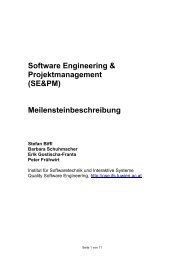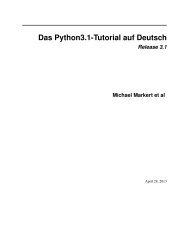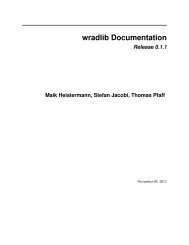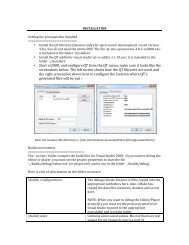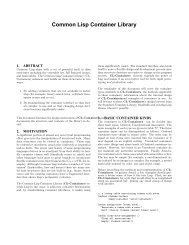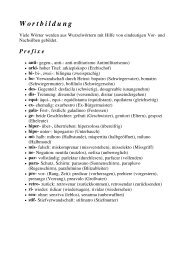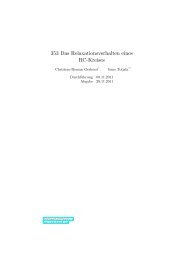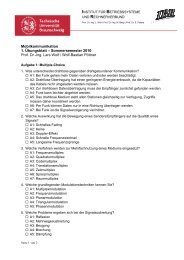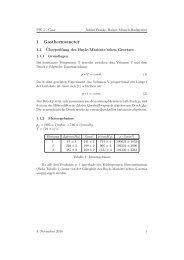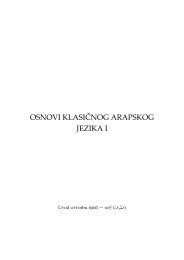P-Technique Demonstrated in Determining ... - Bitbucket
P-Technique Demonstrated in Determining ... - Bitbucket
P-Technique Demonstrated in Determining ... - Bitbucket
Create successful ePaper yourself
Turn your PDF publications into a flip-book with our unique Google optimized e-Paper software.
DECEMBER, 1947<br />
PSYCHOMETRIKA--VOL 12, NO. 4<br />
P-TECHNIQUE DEMONSTRATED IN DETERMINING PSYCHO-<br />
PHYSIOLOGICAL SOURCE TRAITS IN A<br />
NORMAL INDIVIDUAL<br />
R. B. CATTELL, A. K. S. CATTELL, AND R. M. RHYMER<br />
UNIVERSITY OF ILLINOIS<br />
P-technique, a method employ<strong>in</strong>g <strong>in</strong>tra-<strong>in</strong>dividual correlation, is<br />
tried out for the first time. As part of the general design it uses<br />
some variables the same as those <strong>in</strong> a coord<strong>in</strong>ated R-technique study<br />
and a second, parallel P-technique study with a cl<strong>in</strong>ical case. Def<strong>in</strong>ite<br />
factors are obta<strong>in</strong>ed among the psychological and physiological variables,<br />
which can be mutually matched. One is a fatigue factor, but<br />
the rest are general personality factors readily identifiable with those<br />
obta<strong>in</strong>ed <strong>in</strong> past R-technique researches.<br />
I. Aims and Prerequisites of P-<strong>Technique</strong><br />
In 1943 it was suggested by Cattell (4) that functionally unitary<br />
personality traits, especially of dynamic modality, might be discovered<br />
by "temporal sequence studies," notably by employ<strong>in</strong>g a form<br />
of <strong>in</strong>trvAndividual correlation. Further consideration of this technique<br />
<strong>in</strong> the fuller perspective of the covar~ation chart (5) revealed<br />
it to have the promise of a systematic new approach, additional to,<br />
and perhaps as important as, the familiar R-technique, or its successor,<br />
Q-technique (3, 16).* It seemed appropriate, therefore, to call<br />
this <strong>in</strong>tra-<strong>in</strong>dividual "correlation of occasions" P-technique, homologously<br />
with the older methods (7).<br />
The general theory and research prospects <strong>in</strong> regard to P-technique<br />
have been set out <strong>in</strong> earlier publications (4, 7). Essentially<br />
it is a method for apply<strong>in</strong>g experimental measurement with co-variational<br />
analysis to the s<strong>in</strong>gle case. This means that one person must<br />
be measured on a collection of tests on a series of occasions. The<br />
analysis is then made on coefficients obta<strong>in</strong>ed from the correlations<br />
of traits <strong>in</strong> which the unit of entry is the day (or hour) of observation.<br />
The correlations can then be exam<strong>in</strong>ed and analyzed to yield<br />
<strong>in</strong>formation either about surface traits (correlation clusters) alone,<br />
or, with more technical f<strong>in</strong>ish, about source traits (correctly rotated<br />
*What is set out <strong>in</strong> references (3) and (16) may be briefly summarized<br />
by say<strong>in</strong>g that <strong>in</strong> R-technique we correlated test vwriahles with regard to a series<br />
of persons; <strong>in</strong> Q-technique we correlate persons with re~rd to a series of tests.<br />
In P-technique we aga<strong>in</strong> correlate test variables, but with regard to a series of<br />
l OC,Caslons and with<strong>in</strong> a s<strong>in</strong>gle person. Practically all factor analyses yet pubisned<br />
have been <strong>in</strong> terms of R-technique and the rema<strong>in</strong>der <strong>in</strong> Q-technique.<br />
267
268 PSYCHOMETRIKA<br />
factors). The functional unities thus revealed will be unique traits.<br />
Unique surface or source traits are of two k<strong>in</strong>ds: (1) <strong>in</strong>tr<strong>in</strong>sic uniq~<br />
trots, unique because they <strong>in</strong>volve a dimension (quality) not found<br />
<strong>in</strong> any other <strong>in</strong>dividual, e.g., a sixth f<strong>in</strong>ger, and (2) velative unique<br />
traits (if the language specialist will forgive the juxtaposition) <strong>in</strong><br />
which the unique trait has a pattern approximat<strong>in</strong>g a common trait.<br />
P-technique reveals relative unique traits. There is no need of a method<br />
to reveal <strong>in</strong>tr<strong>in</strong>sic unique traits, which are <strong>in</strong> any case too rare for<br />
consideration.*<br />
As <strong>in</strong>dicated <strong>in</strong> the open<strong>in</strong>g sentence, P-technique has particular<br />
promise <strong>in</strong> dynamic and cl<strong>in</strong>ical psychology, where it can, at least<br />
<strong>in</strong> pr<strong>in</strong>ciple, fuJly cope with those problems of discover<strong>in</strong>g unique dynamic<br />
structure which some psychologists have claimed to lie beyond<br />
experimental and statistical approach. What rema<strong>in</strong> to be cleared up,<br />
beyond these theoretical pr<strong>in</strong>ciples, are questions of the k<strong>in</strong>d listed<br />
below, which require practical attempts with P-technique <strong>in</strong> research<br />
situations. The present pioneer study, and another directed specifically<br />
to a cl<strong>in</strong>ical case (10), have the purpose of (1) illustrat<strong>in</strong>g the<br />
method and (2) throw<strong>in</strong>g light on personality structure, particularly<br />
with regard to the follow<strong>in</strong>g questions:<br />
(1) Does the relative unique trait approximate to the common<br />
trait <strong>in</strong> the same field ? A factor analysis of the same, identical variables<br />
by R-technique, on a large group of people, is now <strong>in</strong> progress,<br />
so that factors may be compared with those already published here.<br />
An R-technique study of approximately similar variables already exists<br />
(6).<br />
(2) How great is the scatter of relative unique traits about the<br />
central form, if the latter corresponds to the common trait ? A factor<br />
analysis is also <strong>in</strong> progress on a second <strong>in</strong>dividual (10) chosen to<br />
be very different from the present one, and doubtless further <strong>in</strong>stances<br />
will multiply to answer this question fully.<br />
(3) Is P-technique more efficacious, as theory suggests, <strong>in</strong> yield<strong>in</strong>g<br />
the pattern of dynamic traits than of other modal lties ? The variety<br />
of variables possible <strong>in</strong> a small study may or may not permit an<br />
answer to this.<br />
* Actually there appear to be three senses <strong>in</strong> which uniqueness has been<br />
claimed for personality measurements. It would greatly aid clarity ,~f the de-<br />
.baters would <strong>in</strong>dicate which sense is <strong>in</strong>tended. They are: (1) uniqueness of <strong>in</strong>dividual<br />
personality as a unique comb<strong>in</strong>ation (pattern) of con~mon traits. This<br />
has ,been po<strong>in</strong>ted out, <strong>in</strong> redly to Allport's contention that factors cannot do justice<br />
to uniqueness, by Wolfle and others (7) ; (2~ uniqueness of ~ne iorm (loaa<strong>in</strong>g<br />
pattern) of the trait by which the <strong>in</strong>dividual is to be measured. This may be<br />
due to either (a) <strong>in</strong>tr<strong>in</strong>sic uniqueness aris<strong>in</strong>g from an entirely new dimension<br />
<strong>in</strong> the <strong>in</strong>dividual or, (b) relative uniqueness, as a divergence of the trait from<br />
the common pattern, ~s <strong>in</strong>dicated above.
RAYMOND B. CATTELL, A. K. S. CATTELL, AND R. M. RHYMER 269<br />
S<strong>in</strong>ce the first theoretical presentation (4) and discussion (5, 7)<br />
of P-technique there has been no experiment which could be taken as<br />
an illustration of its work<strong>in</strong>g except possibly that of Baldw<strong>in</strong> (2)<br />
which was apparently conceived <strong>in</strong> a different theoretical framework.<br />
Prior to factor analysis (or without its employment) there have, however,<br />
been quite a number of experiments collect<strong>in</strong>g measurements on<br />
various functions on a s<strong>in</strong>gle <strong>in</strong>dividual from day to day, notably that<br />
of Dodge (12). It is possible that some of the data reported <strong>in</strong> these<br />
studies could be analyzed <strong>in</strong> the present more complex frame of reference<br />
to answer the newer questions propounded above. Baldw<strong>in</strong>'s<br />
data do not immediately throw light on these questions because of the<br />
differences between his approach and that required by P-technique.<br />
In the first place his variables have not been chosen to constitute a<br />
complete sampl<strong>in</strong>g of the personality sphere, such as might encompass<br />
the pr<strong>in</strong>cipal personality factors found by R-technique, and, <strong>in</strong> the second<br />
place, his factors are not f<strong>in</strong>ally rotated, regardless of orthogonality,<br />
for simple structure. These methodological differences, <strong>in</strong> a<br />
study excellent with<strong>in</strong> its own framework, prevent any fruitful comparisons<br />
of our results or any attempt to obta<strong>in</strong> confirmation from his<br />
results of the well-known C, E, and F personality factors (to which<br />
his f<strong>in</strong>d<strong>in</strong>gs have some fa<strong>in</strong>t resemblance) found <strong>in</strong> R-technique.*<br />
Some theoretical considerations of a narrowly statistical nature<br />
rema<strong>in</strong> to be considered <strong>in</strong> develop<strong>in</strong>g this new method, but it would<br />
be <strong>in</strong>appropriate to debate these <strong>in</strong> any detail until the basic questions<br />
have been answered. The latter concern whether the correlations obta<strong>in</strong>ed<br />
<strong>in</strong> this way transcend chance error, whether they yield factors<br />
hav<strong>in</strong>g psychological mean<strong>in</strong>g and <strong>in</strong>terest, and whether the factors<br />
are of the same general nature as the R-technique personality factors.<br />
Some statistical conditions scarcely need discussion; for example, <strong>in</strong><br />
us<strong>in</strong>g the product-moment formula the measurements must have the<br />
same closeness to a normal distribution as is reqmred for R-technique.<br />
The pr<strong>in</strong>cipal new problem concerns whether systematic trends<br />
<strong>in</strong> the measurements as they are made from day to day--trends runn<strong>in</strong>g<br />
<strong>in</strong> one direction from beg<strong>in</strong>n<strong>in</strong>g to end, such as might be associated<br />
with learn<strong>in</strong>g, maturation, or seasonal effect--should first be<br />
partialled out as "extraneous" to personality study. At least <strong>in</strong> an<br />
<strong>in</strong>itial study of this k<strong>in</strong>d the writer is quite opposed to partiall<strong>in</strong>g out<br />
* It is perhaps of historical <strong>in</strong>terest that Baldw<strong>in</strong> appears not to have viewed<br />
his experiment as an example of P-technique, cognate with the R- and Q-techniques.<br />
He regards his procedure, mistakenly <strong>in</strong> the writer's op<strong>in</strong>ion, as a statistical<br />
derivative of an earlier approach study<strong>in</strong>g frequency of association of responses<br />
<strong>in</strong> a s<strong>in</strong>gle <strong>in</strong>dividual (1). His contribution to personality study <strong>in</strong> the<br />
latter is a completely novel method, sui ,aeneris. To conceive correlation with<strong>in</strong><br />
the s<strong>in</strong>gle <strong>in</strong>dividual <strong>in</strong> this frame of reference is to miss the wider scope and<br />
flexibility of P-technique.
270 FSYCHOMETRIKA<br />
trends. It is better to factorize the untouched matrix and deal with<br />
trend factors as such if they appear. Any factor show<strong>in</strong>g a high load<strong>in</strong>g<br />
with a measure of sequential order of experiments may be a learn<strong>in</strong>g<br />
or maturation factor only. On the other hand it may be a true<br />
personality factor <strong>in</strong> which, through circumstances, there has been a<br />
cont<strong>in</strong>uous development dur<strong>in</strong>g the period of experiment. For example,<br />
the C factor of Integration vs Neurosis might show such a<br />
trend dur<strong>in</strong>g a course of psychotherapy.<br />
To anticipate momentarily our f<strong>in</strong>d<strong>in</strong>gs, let it be said that we<br />
found no such global trend factor. On the other hand, we did f<strong>in</strong>d a<br />
factor highly loaded with the hour of the day at which experiments<br />
were carried out. This proved to be a fatigue factor, readily dist<strong>in</strong>guishable<br />
from personality factors by its negligible load<strong>in</strong>g <strong>in</strong> any<br />
trait permanently <strong>in</strong> personality.<br />
In conclusion the reader should be rem<strong>in</strong>ded that the full evaluation<br />
of the present method can be ga<strong>in</strong>ed only by comparison of the<br />
present results with those of two other researches, one <strong>in</strong> R-technique<br />
(I1), one <strong>in</strong> P-technique with an "abnormal," cl<strong>in</strong>ical case (10),<br />
which were planned as part of a total study on the new method. These<br />
studies have, however, been carried out (and published) <strong>in</strong>dependently<br />
<strong>in</strong> order that the f<strong>in</strong>d<strong>in</strong>gs as such may not be mutually <strong>in</strong>fluenced.<br />
They are <strong>in</strong>dependently founded pillars, which may or may not prove<br />
suitable to support the hypothetical general conclusion.<br />
II. Description of the Experiment<br />
a. Subject and Sett<strong>in</strong>g.--The subject was a "normal" adult, not<br />
deviat<strong>in</strong>g noticeably from the averagg except <strong>in</strong> <strong>in</strong>telligence. She was<br />
a 29-year-old woman, formerly a university <strong>in</strong>structor, engaged <strong>in</strong><br />
domestic duties dur<strong>in</strong>g the time of this experiment.<br />
Each day for 9 weeks (55 days, ow<strong>in</strong>g to week-end <strong>in</strong>terruptions),<br />
runn<strong>in</strong>g from the 22nd of April to the 19th of June, 1946,<br />
the subject was (1) measured on the same batch of test variables, (2)<br />
rated by close observers on personal behavior, and (3) self-rated on<br />
a personality questionnaire. The sessions were held at times scattered<br />
as evenly as possible over the day from 8 A.M. to l0 P.M., <strong>in</strong><br />
order to establish the diurnal pattern of fatigue.<br />
b. Description of Variables.--<br />
(1) Objective tests.--The choice of objective tests was determ<strong>in</strong>ed<br />
by (a) the need to co<strong>in</strong>cide with the R-technique study, <strong>in</strong><br />
which tests most promis<strong>in</strong>g as measures of personality factors were<br />
selected; (b) the requirement that the same form of test could be<br />
re-adm<strong>in</strong>istered aga<strong>in</strong> and aga<strong>in</strong>. This elim<strong>in</strong>ated some of the more
RAYMOND B. CATTELL, A. K. S. CATTELL, AND R. M. RHYMER 271<br />
<strong>in</strong>terest<strong>in</strong>g tests from (a).<br />
1. Salivary pH (2).*--Measured, positively for alkal<strong>in</strong>ity, by a<br />
standard pH meter.<br />
2. Disposition Rigidity or Perseveratian (8).--Two sub-tests<br />
only. (a) Same sentence written with forward (normal) and with<br />
backward movement of pencil; (b) multiplication of numbers <strong>in</strong> ord<strong>in</strong>ary<br />
way and multiplication <strong>in</strong> which letters stand for numbers.<br />
The sentence and the code were altered every day. Speed of the old<br />
activity was divided by speed of the novel activity, accord<strong>in</strong>g to disposition<br />
rigidity f<strong>in</strong>d<strong>in</strong>gs (8). One m<strong>in</strong>ute was spent on each of four<br />
activities. The second and novel test was rejected later as not correlat<strong>in</strong>g<br />
with the standard motor rigidity test.<br />
3. Myok<strong>in</strong>esis (4).--The work of Johnson (13) and of Mira<br />
(14) suggests that magnitude and variability of movement may relate<br />
to surgency-desurgency (F factor) or to emotional adjustment<br />
(C factor). As <strong>in</strong> Mira's technique, S with eyes closed drew lefthanded<br />
four rows of ten l<strong>in</strong>es side by side with the stroke (a) downward<br />
(b) upward (c) downward (d) upward. (a) and (b) were estimated<br />
to be one, and (c) and (d) two <strong>in</strong>ches <strong>in</strong> length. The mean<br />
length of l<strong>in</strong>e <strong>in</strong> four rows was used here, though other <strong>in</strong>dices will<br />
be tested later.<br />
4. Reaction time (5).--To light <strong>in</strong> dark box: (a) ten with a<br />
warn<strong>in</strong>g signal two seconds before light; (b) ten with irregular warn<strong>in</strong>g<br />
<strong>in</strong>terval of 1 to 3 seconds; mean of both.<br />
5. Ratio of Reavtion Times (6).--Mean time for regular warn<strong>in</strong>g<br />
divided by time with irregular warn<strong>in</strong>g.<br />
6. Fluency and Thematic Apperception (7).--(a) Words <strong>in</strong> one<br />
m<strong>in</strong>ute complet<strong>in</strong>g a story <strong>in</strong>dicated by an open<strong>in</strong>g sentence (different<br />
each day) ; (b) words <strong>in</strong> two m<strong>in</strong>utes <strong>in</strong> one T.A.T. picture when<br />
<strong>in</strong>structed to make a dramatic story; (c) draw<strong>in</strong>gs <strong>in</strong> one m<strong>in</strong>ute on<br />
each of two fluency cards (7).<br />
7. Reversible Perspective (3).- Uncontrolled cube reversal,<br />
number of reversals <strong>in</strong> two m<strong>in</strong>utes' fixation.<br />
8. Psyvhogalvanic Reflex Resistance (not f<strong>in</strong>ally factorized<br />
here.) Absolute resistance 15 m<strong>in</strong>utes after be<strong>in</strong>g connected to apparatus.<br />
* The number <strong>in</strong> parentheses refers to the number of this variable <strong>in</strong> the factor<br />
table, page 284.
272 PSYCHOMETRIKA<br />
9. Psychogalvanic Reflex Deflection Frequency (11).--Number<br />
of deflections (greater than a 5% m<strong>in</strong>imum magnitude) while idly<br />
look<strong>in</strong>g <strong>in</strong>to dark box for three m<strong>in</strong>utes.<br />
10. Psychogalvanic Reflex Mean Deflection (10).--To (1) loud<br />
sound; (2) electric shock; (3) effort of learn<strong>in</strong>g; and (4) recall<strong>in</strong>g<br />
word list: worked out as per cent loss of resistance.<br />
11. Psyc~togalvanic Reftex Upward Drift (12).--S left relaxed<br />
with <strong>in</strong>struction "No more shock." Recovery of resistance, as upward<br />
drift, over 30-second <strong>in</strong>terval, immediately after shock.<br />
12. Endurance (not factarized).--Position on dial at which S<br />
reported mount<strong>in</strong>g electric shock was becom<strong>in</strong>g unbearable. This S,<br />
on the apparatus used for the men and women <strong>in</strong> the R-technique<br />
study, was unfortunately <strong>in</strong> the m<strong>in</strong>ority which reached the "ceil<strong>in</strong>g"<br />
of the shock strength without protest. Consequently we recorded <strong>in</strong>stead<br />
the "cost" of this endurance <strong>in</strong> terms of P.G.R. resistance drop<br />
and subsequent rise.<br />
13. Suggestibility (9).--The sway test as used by Hull, Eysenck,<br />
and others and suggested b~ Eysenck (13) to correlate with C factor<br />
(general neuroticism and emotionality) : (a) <strong>in</strong>ches forward m<strong>in</strong>us<br />
backward when phonograph record suggests "fall<strong>in</strong>g forward, fall<strong>in</strong>g<br />
forward"; (b) <strong>in</strong>ches backward m<strong>in</strong>us forward with suggestion<br />
"You are beg<strong>in</strong>n<strong>in</strong>g to fall backward," similarly for one m<strong>in</strong>ute.<br />
14. Memory Total (14).--While attached to the P.G.R., S was<br />
asked to memorize as many as possible of 18 words, of which 6 were<br />
emotionally colorless (table, street) and 12 emotional (3 elation, 3<br />
frustration-anger, 3 fear, 3 depression). One m<strong>in</strong>ute was allowed, permitr<strong>in</strong>g<br />
at least four read<strong>in</strong>gs. Recall was tested five m<strong>in</strong>utes later,<br />
20 seconds be<strong>in</strong>g allowed.<br />
15. Memory Ratio Emotional to Non-Emotiov~al (13).--tLutio of<br />
emotional to non-emotional words <strong>in</strong> 13. A new list of words was<br />
made out each day.<br />
These tests were given <strong>in</strong> the order <strong>in</strong>dicated, except 14 and 15,<br />
where memoriz<strong>in</strong>g occurred after 9 and recall after 10.<br />
(2) Behavior rat<strong>in</strong>gs.--While it would be very relevant to <strong>in</strong>elude<br />
rat<strong>in</strong>gs on various dynamic <strong>in</strong>terests, the necessity of conf<strong>in</strong><strong>in</strong>g<br />
ourselves to about a dozen variables <strong>in</strong>cl<strong>in</strong>ed us to choose the primary<br />
personality source traits (7), by which the whole personality sphere<br />
can be covered. Some of these are probably dynamic, and <strong>in</strong> any case<br />
we also had records of dreams and daily activities which could later<br />
be analyzed <strong>in</strong>to dynamic <strong>in</strong>terests.
RAYMOND B. CATTELL, A. K. S. ~ATTELL, AND R. M. RHYMER 273<br />
Each of ten factors (Factor B, Intelligence, and the doubtful L<br />
factor were omitted) was rated immediately before the experiment,<br />
on behavior of the preced<strong>in</strong>g two hours, by the experimenter and the<br />
husband of the subject, on a graphic scale. The def<strong>in</strong>itions were as<br />
given elsewhere (7). However, it is important to remember that these<br />
rat<strong>in</strong>gs could not be reliable assessments of the whole factor but only<br />
of specific behavior central to the factor. For example, cyclothymia<br />
was assessed ma<strong>in</strong>ly on "easy-go<strong>in</strong>g cooperativeness."<br />
1. Factor A. Cyclothyme vs schizothyme. Pr<strong>in</strong>cipally easy-go<strong>in</strong>g<br />
cooperativeness versus obstructiveness.<br />
2. Factor C. Emotional stead<strong>in</strong>ess vs general emotionality and<br />
neuroticism.<br />
3. Factor D. Hypersensitive, sthenic emotionality vs phlegmatic<br />
frustration tolerance. Pr<strong>in</strong>cipally excitable, attention-gett<strong>in</strong>g behavior.<br />
4. Factor E. Dom<strong>in</strong>ance vs submissiveness.<br />
5. Factor F. Surgency vs. desurgency, por<strong>in</strong>cipally cheerfulness,<br />
placidity, talkativeness vs worried, depressed.<br />
6. Factor G. Positive character vs immature dependence. Pr<strong>in</strong>cipally<br />
perseverance, persistence, and will qualities.<br />
7. Factor H. Adventurous cyclothymia vs withdrawn schizothymia.<br />
Pr<strong>in</strong>cipally friendly, outgo<strong>in</strong>g behavior vs shyness, withdrawal.<br />
8. Factor I. Sensitive, anxious, imag<strong>in</strong>ative emotionality vs rigid,<br />
tough poise. Pr<strong>in</strong>cipally as jump<strong>in</strong>ess and over-reaction socially<br />
vs poise.<br />
9. Factor J. Vigorous, determ<strong>in</strong>ed character vs neurasthenia.<br />
10. Factor K. Intellectual, cultured m<strong>in</strong>d vs boorishness. Pr<strong>in</strong>cipally<br />
rated as keenness of <strong>in</strong>tellectual <strong>in</strong>terests and analytical vigor<br />
of m<strong>in</strong>d on the day <strong>in</strong> question.<br />
(3) Self-Rat<strong>in</strong>gs.--The pr<strong>in</strong>cipal factors discovered <strong>in</strong> questionnaires,<br />
by Guilford, Vernon, Reyburn, Taylor, and others have been<br />
summarized elsewhere (7) by Cattell and equated, on the basis of<br />
mean<strong>in</strong>g and the meagre empirical evidence yet available, to the pr<strong>in</strong>cipal<br />
external behavior factors. As an <strong>in</strong>quiry on the soundness of<br />
this match<strong>in</strong>g, each of the behavior factors used <strong>in</strong> the study was represented<br />
also by one of these questionnaire factors, the two highestloaded<br />
questionnaire items be<strong>in</strong>g employed for this purpose. The<br />
rat<strong>in</strong>gs of the two observers and the self-rat<strong>in</strong>gs by the subject<br />
through the questionnaire items were, however, thrown together,<br />
as <strong>in</strong>dicated below, only when all three <strong>in</strong>tercorrelations showed<br />
adequate reliability. This occurred <strong>in</strong> all but two of the factors.<br />
Two questionnaire factors represent factors not known <strong>in</strong> be-
274 PSYCHOMETRIKA<br />
havior rat<strong>in</strong>gs. The subject answered all these questions at the beg<strong>in</strong>n<strong>in</strong>g<br />
of each session, not by "Yes" or "No," but by a mark on a<br />
graphic scale.<br />
It was planned, wherever possible, to pool the <strong>in</strong>ner and outer<br />
(behavior-rat<strong>in</strong>g and self-rat<strong>in</strong>g, questionnaire) estimates of each<br />
factor (giv<strong>in</strong>g equal weight to each), <strong>in</strong> order to beg<strong>in</strong> the factor<br />
analysis with fewer and more reliable variables. The pool<strong>in</strong>g was cartied<br />
out, however, only when all three correlations (between the two<br />
raters and the self-rater) were positive and significant. In all cases<br />
the correlations were positive and rather low, but no lower than might<br />
be expected from an <strong>in</strong>tr<strong>in</strong>sically very valid measure based on only<br />
a two-item questionnaire. The highest was .90, the median .43, the<br />
lowest .05. The lowest r's were not between the observers but between<br />
the self-rater and the observer, and might be due to the <strong>in</strong>ner and<br />
outer factors not be<strong>in</strong>g perfectly matched.*<br />
IIL .,4naJysis of Obyective Test Patterns<br />
In any factor analysis designed to give perspective on over-all<br />
personality patterns--an important objective <strong>in</strong> a first P-technique<br />
study--it is desirable (a) to have the whole personality sphere represented<br />
and (b) not to have some variable represent<strong>in</strong>g, alone, a<br />
whole factor while other factors are represented by many variables,<br />
for <strong>in</strong> this way first- and second-order factors may be confused. The<br />
first is assured by bas<strong>in</strong>g our approach on previous factorization of<br />
the personality sphere. To meet the second condition, and also for<br />
economy of factorization labor, it was decided to factorize the objective<br />
~sts first. The factors from the tests would then be factorized<br />
with the rat<strong>in</strong>g factors <strong>in</strong> a s<strong>in</strong>gle matrix, to discover possible identities.<br />
The objective test factors, after rotation for simple structure,<br />
are set out <strong>in</strong> Table 2 and the ensu<strong>in</strong>g description.<br />
One or two variables were omitted from the f<strong>in</strong>al factorization,<br />
notably the absolute P.G.R. resistance, because ~t seemed affected by<br />
sweat<strong>in</strong>g from hot weather for the whole of one week, and the memoriz<strong>in</strong>g,<br />
because the subject expla<strong>in</strong>ed afterwards that she had em-<br />
* The unsatisfactory variables were (1) A, <strong>in</strong> which the behavior rat<strong>in</strong>gs<br />
correlated only .17 and .18 with the questionnaire, though .66 with each other.<br />
We split this <strong>in</strong>to A 1, self-rat<strong>in</strong>g and A~, behavior rat<strong>in</strong>g. (2) I factor, all low<br />
but reta<strong>in</strong>ed as a unity. (3) D. Sthenic-emotionality, similar. (4) K factor,<br />
like A, but here only the observers' rat<strong>in</strong>g was reta<strong>in</strong>ed. (4). The two questions <strong>in</strong><br />
QPIX (see 7) correlated only .07. Only that on daydream<strong>in</strong>g was reta<strong>in</strong>ed, because<br />
the subject said she had no confidence <strong>in</strong> estimates of the goodness of her memory.<br />
It is <strong>in</strong>terest<strong>in</strong>g that the <strong>in</strong>ternal validities here were higher for those factors<br />
(notably G, <strong>in</strong> which the r's were .89, .51, .90) where def<strong>in</strong>ition has been<br />
good and variance large <strong>in</strong> R-~chniquestudies, than for those, notably D & K,<br />
which have been difficult to smoiiize <strong>in</strong> ~-zecnnique t'~J.
RAYMOND B. CATTELL, A. K. S. CATTELL~ AND R. M. RHYMER 275<br />
ployed three different mnemonics at different times. The correlations<br />
both for memoriz<strong>in</strong>g and for ratio of emotional to non-emotiop~l<br />
words recalled were, however, so consistent with respect to the factor<br />
pattern which appeared later that we discounted the subject's impressions<br />
and <strong>in</strong>cluded it (by a secondary calculation from its correlations<br />
with highly loaded items <strong>in</strong> each factor. These were very consistent,<br />
but the load<strong>in</strong>gs for these two items are naturally approximate).<br />
Factor I. Emotional Abundance vs Emotional Dewrth. ~ This<br />
loads high sway suggestibility and high P.G.R. deflection decidedly;<br />
and also, less highly, ratio of emotional to non-emotional recall, and<br />
upward drift on P.G.R. and frequency of deflections. It has no relation<br />
to time of day or sequence of experiments. Through these runs<br />
an emotional responsiveness to environment which might almost be<br />
called a dynamic vigor or read<strong>in</strong>ess, were it not that sway suggestibility<br />
has been connected <strong>in</strong> the past with the more neurotic forms<br />
of emotionality.<br />
Factor H. Physiological Ease vs Emergency Alertness.--Loads<br />
slow reaction time, salivary alkal<strong>in</strong>ity, slow reversible perspective<br />
and, less clearly, poor memoriz<strong>in</strong>g, high ratio emotional to unemotional<br />
recall, low rigidity, and high ratio of regular to irregular<br />
warned reaction time. These variables are consistently and appreciably<br />
all negatively related to sequence of experiments, i.e., to practice.<br />
Favtor III. Fatigue vs Energy Reserve. -- Loads time of day,<br />
quickness of reversible perspective, frequency of P.G.R. deflection,<br />
magnitude upward resistance drift dur<strong>in</strong>g relaxation, and ratio of<br />
warned to unwarned reaction time. Except for the slightness of<br />
perseveration-rigidity load<strong>in</strong>g (which, however, reaches significance<br />
<strong>in</strong> some rotations) these tests comprise known tests of fatigue and the<br />
factor is clearly one of diurnal fatigue.<br />
Factor IV.bUncontrol vs Inhibition. This loads Fluency, Perseveration-Rigidity,<br />
large movements <strong>in</strong> myok<strong>in</strong>esis and, less def<strong>in</strong>itely,<br />
good memoriz<strong>in</strong>g, sway suggestibility, and P.G.R. Deflection. This<br />
factor is correlated positively with lateness of experiment sequence,<br />
but less so than II. S<strong>in</strong>ce rigidity (9), fluency (8) and sway suggestibility<br />
(13) have all <strong>in</strong>dependently been regarded as expressions of<br />
lack of <strong>in</strong>tegration and will (while large careless movements have the<br />
same character) it seems that this is def<strong>in</strong>itely some k<strong>in</strong>d of lack of<br />
<strong>in</strong>hibition, with greater spontaneity and carelessness.<br />
The factorization which yielded these factors was <strong>in</strong>tr<strong>in</strong>sically<br />
very satisfactory, first <strong>in</strong> that both McNemar's and Tucker's criteria<br />
showed def<strong>in</strong>itely four factors, second <strong>in</strong> that the simple structure
276 PSYCHOMETRIKA<br />
was <strong>in</strong>dubitable and clear-cut, and third <strong>in</strong> that simple structure, atta<strong>in</strong>ed<br />
with unknown, numer~ically <strong>in</strong>dexed variables, has led to certa<strong>in</strong><br />
mean<strong>in</strong>gful factors. For example, time of day is central <strong>in</strong> III<br />
and is entirely absent from other factors, reaction time is wholly <strong>in</strong><br />
II, Factor III is clearly diurnal fatigue, and so on. The obliquities of<br />
Factors I and IV and the novelty of other factors can therefore be<br />
accepted with confidence.<br />
IV. The Pr<strong>in</strong>cipal Psycho-Physiological Source Traits <strong>in</strong> the<br />
Given Individual<br />
The <strong>in</strong>dividual's level for each of the above factors on each occasion<br />
was worked out by add<strong>in</strong>g the standard scores on the two or<br />
three highest variables <strong>in</strong> each factor.* These "objective test factors,"<br />
as we shall call them, were next <strong>in</strong>tercorrelated <strong>in</strong> a s<strong>in</strong>gle matrix<br />
with the rated and self-rated primary personality factors. The general<br />
justification of this procedure is pla<strong>in</strong>--we wished (1) to "place"<br />
the test factors <strong>in</strong> terms of known primary personality factors and<br />
(2) to beg<strong>in</strong> to express and def<strong>in</strong>e the personality factors by def<strong>in</strong>ite<br />
objective measurements wit~_<strong>in</strong> the rough outl<strong>in</strong>es of rat<strong>in</strong>gs. Butthe<br />
factorial problems which arise here need brief discussion.<br />
The representation of the fourteen test variables by four factors<br />
<strong>in</strong> the f<strong>in</strong>al matrix is, of course, dictated largely by economy. If a<br />
test factor proves to be identical with a behavior factor, this will be<br />
revealed with reasonable certa<strong>in</strong>ty by the analysis. If, on the other<br />
hand, it belongs to a different universe or a different order, this also<br />
will be revealed as well by our present procedure as by lump<strong>in</strong>g<br />
all variables together from the beg<strong>in</strong>n<strong>in</strong>g.<br />
An element of doubt arises only ,<strong>in</strong> so far as we are <strong>in</strong> doubt<br />
whether the factorization of the primary personality factors will yield<br />
primary or second-order personality factors. If our rat<strong>in</strong>gs of each<br />
factor were <strong>in</strong>deed absolutely pure measures of each factor, only second-order<br />
factors would emerge. To decide whether the test factors<br />
correspond to first- or second-order personality factors we should need<br />
only to observe whether (a) the direct correlations <strong>in</strong> the present<br />
matrix between test and rat<strong>in</strong>g factors or (b) load<strong>in</strong>gs of the test<br />
factors <strong>in</strong> second-order factors, when corrected for attenuation, approximate<br />
unity. But our rat<strong>in</strong>gs are not pure measures of each primary<br />
factor and are presumably contam<strong>in</strong>ated <strong>in</strong> various degrees with<br />
* Factor I from suggestibility, P.G.R. deflection, and half P.G.R. rise.<br />
Factor II from salivary alkal<strong>in</strong>ity and slowness reaction time.<br />
Factor III from time of day, speed reversible perspective, and half of reaction<br />
time ratio, P.G.R. deflection, and P.G.R. rise.<br />
Factor IV from variability of myok<strong>in</strong>esis, magnitude of fluency, and rigidity.
RAYMOND B. CATTELL, A. K. S. CATTELL, AND R. M. RHYMER 277<br />
other factors. Consequently it seems most likely that the factorization<br />
of the present personality factor matrix will actually yield firstorder<br />
factors, each be<strong>in</strong>g "po<strong>in</strong>ted" by high load<strong>in</strong>g <strong>in</strong> the rated factor<br />
<strong>in</strong>tended to represent it, but also <strong>in</strong>volved to some extent <strong>in</strong> other<br />
"factor" rat<strong>in</strong>gs. This likelihood is <strong>in</strong>creased by the fact that the personality<br />
sphere represented is likely to be widened through the <strong>in</strong>clusion<br />
of test and questionnaire variables. The exam<strong>in</strong>ation of the correlation<br />
matrix before factorization revealed no correlations between<br />
test factors and behavior factors high enough to suggest identity, nor<br />
were the significant r's of a test factor conf<strong>in</strong>ed to one behavior factor.<br />
The actual factorization aga<strong>in</strong> yielded four factors, accord<strong>in</strong>g to<br />
both the Tucker and the McNemar criteria. However, <strong>in</strong> this case the<br />
presumption that more factors should be <strong>in</strong>volved was so great and<br />
the <strong>in</strong>dications of a factor special to three variables <strong>in</strong> the residual<br />
was so strong that we decided to extract a fifth factor, slight though<br />
it was, and attempt rotation with it. Aga<strong>in</strong> simple structure was obta<strong>in</strong>ed<br />
with unusual def<strong>in</strong>iteness and <strong>in</strong>evitableness (over half the<br />
variables <strong>in</strong> the hyperplane) <strong>in</strong> the case of three factors. This occurred<br />
after four rotations <strong>in</strong> each. Another 25 rotations, however, were required<br />
to achieve simple structure on the two rema<strong>in</strong><strong>in</strong>g factors,. 1<br />
and 5; and then, though satisfactory, they did not sit at comfortable<br />
angles near to orthogonality as did the first three factors. Rotation<br />
with the first four factors only yielded simple structure fairly readily<br />
with two, but eighteen more rotations were necessary to get simple<br />
structure with the rema<strong>in</strong>der. Three of these factors are practically<br />
<strong>in</strong>dist<strong>in</strong>guishable <strong>in</strong> load<strong>in</strong>g pattern from Factors A, F, and C above.<br />
The fourth is also clearly the same as G above, but absorbs greater<br />
variance. The second cyclothyme factor H is therefore miss<strong>in</strong>g. These<br />
factors do not have such good hyperplanes as <strong>in</strong> the accepted rotation ;<br />
<strong>in</strong> fact, only 60% of the number <strong>in</strong> the five-factor solution.<br />
In view of the co<strong>in</strong>cidence of the number of factors obta<strong>in</strong>ed --4<br />
to 5-- with the number obta<strong>in</strong>ed <strong>in</strong> two studies (7) of second-order<br />
personality factors, the first hypothesis to consider is that <strong>in</strong> spite of<br />
the reasons stated above these factors are <strong>in</strong>deed second-order factors.<br />
A careful comparison of the present load<strong>in</strong>g patterns with those of<br />
the second-order factors (7) reveals no similarity whatever <strong>in</strong> two<br />
and a very distant similarity <strong>in</strong> the rest--so distant that, <strong>in</strong> conjunction<br />
with the absence of any resemblance <strong>in</strong> their <strong>in</strong>tercorrelation, we<br />
feel justified <strong>in</strong> turn<strong>in</strong>g away confidently to the hypothesis orig<strong>in</strong>ally<br />
suggested: that these are first-order factors. That this latter is true<br />
is witnessed by the ease with which the present factors--listed <strong>in</strong><br />
Table 3 below-- can be matched and identified with well-known primary<br />
personality factors from R-technique. We have only to set aside
278 PSYCHOMETRIKA<br />
for a moment our previous conception of the rated variables as factors<br />
and consider them simply as behavior rated accord<strong>in</strong>g to the given<br />
def<strong>in</strong>ition, <strong>in</strong> order to see the present factors as familiarly patterned<br />
primary personality factors.<br />
Let us first describe the factors, with labels, discuss<strong>in</strong>g the identifications<br />
<strong>in</strong> each case. We shall take them <strong>in</strong> dim<strong>in</strong>ish<strong>in</strong>g order of<br />
magnitude (mean contribution to variance).<br />
Factor $. "'C" Emotionally Stable Character vs Demoralized General<br />
Emotianality. The outstand<strong>in</strong>g load<strong>in</strong>gs are:<br />
c+<br />
Inhibition .......................................... vs<br />
Steady ................................................ vs<br />
Self-sufflcient .................................... vs<br />
.............................................................. VS<br />
Depressed (Solemn) ........................<br />
vs<br />
C M<br />
Uncontrol (Test factor 4) ................. 63<br />
Emotional ............................................. 50<br />
Not self-suf. (Self-rated) .................... 49<br />
Daydream<strong>in</strong>g (Self-rated) ............... 47<br />
Cheerful ................................................. 36<br />
This is clearly the C factor of R-technique studies. Daydream<strong>in</strong>g<br />
as such did not figure <strong>in</strong> those variables, but it could be taken as the<br />
equivalent of "not fac<strong>in</strong>g life, subjective, evasive" (7). The presence<br />
of "cheerful" is rather surpris<strong>in</strong>g, but it evidently functions as the<br />
equivalent of "Frivolous" <strong>in</strong> the R-technique studies (7). Both are<br />
present only <strong>in</strong> very small load<strong>in</strong>gs, but this confirmation throws new<br />
light on the nature of the C factor, <strong>in</strong>dicat<strong>in</strong>g that its positive form<br />
has some sort of sobered, mature <strong>in</strong>hibition, as opposed to immature<br />
frivolous waywardness.<br />
Factor 5. "H" Adventurous Cyclothymia vs Withdrawn Schizothymia.<br />
Load<strong>in</strong>gs <strong>in</strong>:<br />
H+<br />
Friendly, <strong>in</strong>terested <strong>in</strong> people ........ vs<br />
Emotional abundance ...................... vs<br />
Cooperative, easy-go<strong>in</strong>g .................. vs<br />
Self-confident, dom<strong>in</strong>ant ................ vs<br />
Sthenic emotionality ........................ vs<br />
H ~<br />
Withdrawn, cautious, shy ................. 74<br />
Emot. dearth (Test factor 1) ........... 44<br />
Obstructive ........................................... 37<br />
Submissive ............................................. 86<br />
Frustration tolerance ......................... 28<br />
It is <strong>in</strong>terest<strong>in</strong>g to note that two factors <strong>in</strong> the cyclothyme-schizothyme<br />
area are found here as <strong>in</strong> R-technique, but that there is no difficulty<br />
<strong>in</strong> dist<strong>in</strong>guish<strong>in</strong>g between them <strong>in</strong> the sense of the two factors<br />
of the earlier study. Here, as there, the second factor's schizothyme<br />
pole is dist<strong>in</strong>guished by withdrawal ("shy" here; "aloof" <strong>in</strong> the orig<strong>in</strong>al,<br />
7).. Also there is a lack of energy, adventurousness, and self-confidence.<br />
(Self-confident, dom<strong>in</strong>ant, sthenic here; ascendant, expressive,<br />
<strong>in</strong>cont<strong>in</strong>ent, opposed to retir<strong>in</strong>g, quiet, narrow <strong>in</strong> the orig<strong>in</strong>al,<br />
7).
RAYMOND B. CATTELL, A. K. S. CATTELL, AND R. M. RHYMER 279<br />
Factor 1. "A'" Cyclothymia vs SchizothyCnia loads:<br />
A+ A--<br />
Cooperative, easy-go<strong>in</strong>g ................ vs Obstructive ............................................ 60<br />
Friendly, <strong>in</strong>terested <strong>in</strong> people ...... vs Withdrawn, shy ................................... 40<br />
Daydream<strong>in</strong>g (self-rated) ............ vs .................................................................. 50<br />
Vigorous ............................................ vs Languid ................................................. 26<br />
Jumpy, easily embarrassed ............ vs Poised ..................................................... 25<br />
That this is the more simple cyclo-schizo pattern of the orig<strong>in</strong>al<br />
A is shown by the emphasis on obstructiveness--<strong>in</strong>deed the variables<br />
orig<strong>in</strong>ally chosen as straight representatives of A and H have come out<br />
as the highest load<strong>in</strong>gs respectively <strong>in</strong> these factors. This factor seems<br />
to be the more general, generic one by the fact that there is little <strong>in</strong> it<br />
besides the load<strong>in</strong>gs <strong>in</strong> the two orig<strong>in</strong>al cyclo-schizo variables. That<br />
daydream<strong>in</strong>g should appear on the cyclothyme side is a little startl<strong>in</strong>g,<br />
but the subject expla<strong>in</strong>ed that she rated herself not on any <strong>in</strong>tensive<br />
compensatory phantasy life but on pleasant, relaxed mus<strong>in</strong>g<br />
which depended most on whether or not she was <strong>in</strong> a hurry! (Note<br />
also its appearance <strong>in</strong> Surgency, below). In this connection one notes<br />
that "optimistic" appears <strong>in</strong> the orig<strong>in</strong>al cyclothyme factor patterns.<br />
Factor 3. "G" Positive Character Integration vs Immature, Dependent<br />
Character loads:<br />
G+<br />
Persever<strong>in</strong>g, strong-willed ............ vs<br />
Self-sufficient .................................... vs<br />
Shy, cautious .................................... vs<br />
Steady, stable .................................... vs<br />
G--<br />
Quitt<strong>in</strong>g, fickle ................................... 44<br />
Not self-sufficient ............................... 42<br />
Friendly, <strong>in</strong>terested <strong>in</strong> people ......... 40<br />
Emotional ............................................. 37<br />
That this second factor <strong>in</strong> the general realm of character is G<br />
rather than C is evidenced by persistence and self-sufficiency be<strong>in</strong>g<br />
high, while emotional stability, still <strong>in</strong> the pattern (as <strong>in</strong> C), is low.<br />
At first, it is a little surpris<strong>in</strong>g to f<strong>in</strong>d shyness and caution here, but<br />
<strong>in</strong> the orig<strong>in</strong>al R-technique factor (7) "reserve" and "self-consciousness"<br />
appear at about this same level.<br />
Factor 2. "F" Surgency vs Desurgency (or Hysteria-Dysthy~<br />
mia ) loads:<br />
F+ F--<br />
Physiological ease ............................ vs Emergency alertness (Test factor 2) .53<br />
Cheerful, talkative .......................... vs Depressed, worried ............................. 37<br />
Cooperative ........................................ vs Obstructive ........................................... 34<br />
Daydream<strong>in</strong>g .................................... vs ................................................................... 32<br />
Submissive .......................................... vs Dom<strong>in</strong>ant, self-confident ................... 30<br />
Steady emotionally .......................... vs Emotional ............................................. 30<br />
Not self-sufficient (Sociable) ........ vs Self-sufficient ....................................... 27
280 PSYCHOMETRIKA<br />
In this the slightest of factors, we have carried the list<strong>in</strong>g to<br />
<strong>in</strong>clude items beyond the usual m<strong>in</strong>imum of load<strong>in</strong>g, <strong>in</strong> search of more<br />
complete def<strong>in</strong>ition. This factor is clearly surgency, but aga<strong>in</strong> daydream<strong>in</strong>g<br />
seems a little misplaced and aga<strong>in</strong> "dom<strong>in</strong>ance" is likewise<br />
susceptible to slightly different <strong>in</strong>terpretation. In the orig<strong>in</strong>al, "cooperative"<br />
is perhaps equivalent-to "responsive, genial, sociable," and<br />
"self-sufficient" (self-rat<strong>in</strong>g) to "set and smug," or "unsociable" (observer).<br />
In place of "dom<strong>in</strong>ant" (at the negative pole) we f<strong>in</strong>d "hostility"<br />
and <strong>in</strong> place of "submissive" the quality of be<strong>in</strong>g "adaptable and<br />
reasonable." In general, where these differences exist the R-technique<br />
studies must be accepted as giv<strong>in</strong>g the f<strong>in</strong>er mean<strong>in</strong>g, hav<strong>in</strong>g<br />
been based on more def<strong>in</strong>ed variables, but one can at least match the<br />
mean<strong>in</strong>g of the latter <strong>in</strong> the present coarse variables.<br />
Additional evidence, if it were needed, of the above identifications<br />
is found <strong>in</strong> the fact that, except for the F factor and one specific<br />
correlation between C and G, the correlations between factors<br />
are of the same sign and general magnitude as exist among the correspond<strong>in</strong>g<br />
R-technique factors (6). If these r's are supplemented<br />
with those found among the direct estimates of factors, <strong>in</strong> the present<br />
orig<strong>in</strong>al correlation matrix, giv<strong>in</strong>g, <strong>in</strong> all, 55 correlations among<br />
11 factors, 42 of these are of the same sign as those found <strong>in</strong> R-technique.<br />
Twelve of the 13 dissident r's arise from three factors only:<br />
A, E, and F. The possibility of such similarity by chance is not utterly<br />
remote, but the f<strong>in</strong>d<strong>in</strong>g at least contributes a further <strong>in</strong>dependent<br />
probability <strong>in</strong> the direction of these Q-technique factors be<strong>in</strong>g the<br />
same as those of R-technique.<br />
An important f<strong>in</strong>d<strong>in</strong>g is that the pure test factors, with the exception<br />
of the first, align themselves directly with personality rat<strong>in</strong>g<br />
factors, so that each has zero load<strong>in</strong>gs <strong>in</strong> all but one particular member<br />
of the latter. Whether these load<strong>in</strong>gs <strong>in</strong> the particular factor<br />
reach the level necessary for conclud<strong>in</strong>g that test and rat<strong>in</strong>g factor<br />
are one and the same rema<strong>in</strong>s to be tested. Test Factor 2 emerges as<br />
the highest item <strong>in</strong> general personality Factor 2 and Test Factor 4<br />
as the ki~qhest <strong>in</strong> the general personality Factor 4. (That they have<br />
the same numbers is accidental). The actual load<strong>in</strong>gs, hav<strong>in</strong>g regard<br />
to the reliabilities of our estimates of the test factors by simple additioll<br />
of "sub-test" scores, are consistent with complete identification<br />
of Test Factors 2 and 4 with the correspond<strong>in</strong>g over-all rat<strong>in</strong>g factors.<br />
Test factor 3--general diurnal fatigue--does not correlate at all<br />
with Factors 1 through 4, are scarcely significantly with 5. That this<br />
one test factor should be quite unrelated to personality makes good<br />
sense when we realize that it is merely the daily repetitive cycle of<br />
fatigue. Test Factor 1 is unique <strong>in</strong> spread<strong>in</strong>g over four factors,
RAYMOND B. CATTELL, A. K. S. CATTELL, AND R. M. RHYMER 281<br />
though highest <strong>in</strong> that with which we should expect its nature (Emotional<br />
responsiveness) to make it cognate. Exploration of the possibility<br />
that this test factor is some more basic second-order factor reveals<br />
only a slight suggestive resemblance of pattern to second-order<br />
factor SH (7), but noth<strong>in</strong>g conv<strong>in</strong>c<strong>in</strong>g. The agreement of the mean<strong>in</strong>g,<br />
and even of the label, of each of the Test Factors 1, 2, and 4 (assigned<br />
to them at a stage of the research long preced<strong>in</strong>g the f<strong>in</strong>al factorization)<br />
with the behavioral mean<strong>in</strong>g of the personality factors<br />
with which they identify, is strik<strong>in</strong>gly good.<br />
What requires explanation, <strong>in</strong> view of the very def<strong>in</strong>ite identification<br />
of these five P-technique with R-technique factors, is the absence<br />
of some six commonly found factors <strong>in</strong> R-technique. Factor B, general<br />
ability, is obviously absent because we <strong>in</strong>cluded no <strong>in</strong>telligence-demand<strong>in</strong>g<br />
tests. Dom<strong>in</strong>ance "E" is present only as a specific, <strong>in</strong> the rat<strong>in</strong>g<br />
variable set to estimate it, because Dom<strong>in</strong>ance is quite a narrow<br />
factor affect<strong>in</strong>g only social aspects of personality (7). D, sthenic emotionality,<br />
has always been an elusive factor, <strong>in</strong>sufficiently established<br />
by recent work even <strong>in</strong> R-technique. J and K are very slight factors, requir<strong>in</strong>g<br />
populations of two or three hundred cases for their def<strong>in</strong>ition.<br />
Consequently we should not expect them here to acquire variance <strong>in</strong><br />
anyth<strong>in</strong>g but the variable specifically set to measure each. The only<br />
absentee for which no adequate cause is obvious is the Factor I, Anxious,<br />
imag<strong>in</strong>ative emotionality vs Tough poise. In relation to the general<br />
population our subject is extreme <strong>in</strong> I and <strong>in</strong> B, but otherwise<br />
average. Possibly there is some connection.<br />
The rather large correlation of A and F (positive) and of G and<br />
H (negative) may be peculiar to this subject. The exact correlation<br />
among factors <strong>in</strong> one subject promises a new source of personality<br />
uniqueness and one which may be of considerable diagnostic value.<br />
The first correlation might be <strong>in</strong>terpreted, <strong>in</strong> view of our general observation<br />
of this subject, to mean that when she is <strong>in</strong> a cyclothyme,<br />
responsive adjustment-state she tends to shift toward the cheerful<br />
rather than the depressive group of emotions, at least <strong>in</strong> this life situation.<br />
The second may be a form of dynamic equivalence: that when<br />
more than average energy is available it shifts either <strong>in</strong>to the carefree,<br />
adventurous sociability of H or <strong>in</strong>to a heighten<strong>in</strong>g of persistent, seriious<br />
application of G, so that they become <strong>in</strong>versely related. These<br />
and other more speculative hypothetical questions of the relation of<br />
physiological to personality factors will be taken up <strong>in</strong> a later paper,<br />
<strong>in</strong> which the day-to-day changes <strong>in</strong> these five factor measurements<br />
will be related to daily happen<strong>in</strong>gs, records of dreams, and cl<strong>in</strong>icaltype<br />
observations. Any fuller <strong>in</strong>terpretation will be profitable, however,<br />
only when these f<strong>in</strong>d<strong>in</strong>gs can be aligned with those of the second
282 PSYCHOMETRIKA<br />
P-technique study and the R-technique study with identical tests,<br />
which form parallel studies <strong>in</strong> a s<strong>in</strong>gle research plan.<br />
V. Summary<br />
(1) Day-to-day variations <strong>in</strong> personality traits are large enough<br />
to yield, with our present accuracy of measurement and behavior rat<strong>in</strong>g,<br />
significant correlations and def<strong>in</strong>ite factors, by P-technique.<br />
(2) These factors give clear-cut simple structure and are then<br />
easily recognizable as well-known primary personality factors, as obta<strong>in</strong>ed<br />
by R-technique. The correlations among them tend to resemble,<br />
but do not so exactly match, those found <strong>in</strong> R-technique.<br />
(3) Not all R-technique factors appear. However, it is <strong>in</strong>terest<strong>in</strong>g<br />
to f<strong>in</strong>d that the splitt<strong>in</strong>g of the cyclothyme-schizothyme "general<br />
syndrome" <strong>in</strong>to two dist<strong>in</strong>ct factors A and H, and of general character<br />
<strong>in</strong>tegration <strong>in</strong>to two dist<strong>in</strong>ct factors C and G, as <strong>in</strong>dicated <strong>in</strong> Cattell's<br />
R-technique study, is born out here <strong>in</strong> P-technique. In A the<br />
schizothyme pattern emphasizes hostility and tension, <strong>in</strong> H withdrawal<br />
and <strong>in</strong>hibition. In C sober emotional maturity( as opposed to<br />
general emotionality) is emphasized, <strong>in</strong> G perseverance and vigor (as<br />
opposed to emotional dependence). The fifth factor is Surgency-Desurgency,<br />
F.<br />
(4) Four clear-cut factors appear <strong>in</strong> the physiological and psychological<br />
tests. Two appear to be identical with personality factors<br />
F and C. Another is general diurnal fatigue. The last, (I <strong>in</strong> Table 2)<br />
Emotional abundance vs Emotional dearth, load<strong>in</strong>g psychogalvanic<br />
response, ataxic sway under suggestion and P.G.R. drift and frequency,<br />
is pr<strong>in</strong>cipally associated~ with H (Adventurous cyclothymia<br />
vs Withdrawn schizothymia) but possibly shows a little relation also<br />
with C (+) and G (--). Factor A shows no relation to any physiological<br />
factor we measured, agree<strong>in</strong>g with an earlier tentative hypothesis<br />
that A is the environmental and H the constitutional factor <strong>in</strong> schizothymia.<br />
(5) These results suggest new objective test batteries for five<br />
primary personality factors and help clarify the functional nature of<br />
these factors. However, these developments, as well as the answer<strong>in</strong>g<br />
of further theoretical issues <strong>in</strong> factorial personality analysis methods<br />
and the relat<strong>in</strong>g of the present factor variations to daily events,<br />
await the correlat<strong>in</strong>g of the present results with those of the two coord<strong>in</strong>ated<br />
researches--one on R-technique, one demonstrat<strong>in</strong>g the value<br />
of P-technique for cl<strong>in</strong>ical practice.
RAYMOND B. CATTELL, A. K. S. CATTELL, AND R. M. RHYMER 283<br />
Personality Factor Scored<br />
and Direction of Scor<strong>in</strong>g<br />
A. Cyelothymia-Schizothymia<br />
TABLE 1<br />
Factors <strong>in</strong> Self-Rat<strong>in</strong>g<br />
("Yes" <strong>in</strong> negative direction) ........ 1.<br />
("Yes" negative) .............................. 2.<br />
D. Sthenic emotionality<br />
("Yes" positive) ................................ 3.<br />
("Yes" positive) ................................ 4.<br />
F. Su~'gency-Des'u~'gency<br />
("Yes" negative) .............................. 5.<br />
("Yes" negative) ............................ 6.<br />
C. ,~table chwfavter vs Gene~'al em~<br />
tiona]ity<br />
("Yes" negative) ..............................<br />
("Wrong" negative) ........................<br />
QPX. Obsessional <strong>in</strong>flexible vs<br />
Astheniv QPV<br />
Questions Answered by Subject on<br />
Graphic Rat<strong>in</strong>g Scale<br />
Do you feel relatively shy and selfconscious<br />
today, so that you have<br />
tended to keep <strong>in</strong> the background on<br />
social occasions?<br />
Have you felt today that your m<strong>in</strong>d<br />
has tended to move slowly so that<br />
you keep to one track <strong>in</strong> conversation<br />
<strong>in</strong>stead of jump<strong>in</strong>g about?<br />
Have you felt today rather easily excited<br />
and rattled <strong>in</strong> difficult situation<br />
s ?<br />
Do you feel unduly sensitive so that<br />
your feel<strong>in</strong>gs are easily hurt by remarks<br />
?<br />
Have you felt depressed and miserable<br />
for no good reason or have you<br />
felt above average <strong>in</strong> spirits<br />
Have you felt unduly worried and<br />
tense today or not?<br />
7. Have you suffered today from periods<br />
of lonel<strong>in</strong>ess?<br />
8. Is this a day on which everyth<strong>in</strong>g<br />
seems to have gone wrong or on<br />
which th<strong>in</strong>gs go well?<br />
See (7). Asthenic answer .............. 9. Have you .been daydream<strong>in</strong>g much today?<br />
Negative <strong>in</strong> both ................................ 10. Has your memory been good today or<br />
poor and uncontrolled?<br />
E. Dom<strong>in</strong>ance-Submission<br />
("Yes" positive) ................................<br />
("Others" positive) ..........................<br />
11. Have you felt today generally very<br />
self-confident or lack<strong>in</strong>g <strong>in</strong> confidence?<br />
12. When th<strong>in</strong>gs have gone wrong today,<br />
do you th<strong>in</strong>k it has been ma<strong>in</strong>ly your<br />
fault or the fault of others?
284 PSYCHOMETRIKA<br />
TABLE 1 (Cont<strong>in</strong>ued)<br />
QP. Vllla Self-Sufficiency See (7)<br />
("Yes" positive) .................................... 13. Have you felt so absorbed <strong>in</strong> your<br />
work today that you have not noticed<br />
a need for company?<br />
G. Character <strong>in</strong>tegration-Dependence<br />
("Above" positive) ............................ 14.<br />
("Control" positive) ........................ 15.<br />
1. Anxious emotianality-Poise<br />
("Yes" positive) ................................ 16.<br />
("Insomnia" positive) ...................... 17.<br />
K. Cultured m<strong>in</strong>d vs Un<strong>in</strong>tellectual<br />
("Yes" positive) ................................ 18.<br />
Have you been above or below average<br />
<strong>in</strong> your persistence and perseverance<br />
today?<br />
Do you feel that your emotional<br />
moods have been under very good<br />
control or not?<br />
Have you been rather easily startled<br />
and distracted by sudden sounds today<br />
?<br />
Did you fall asleep easily last night<br />
or did you suffer some degree of <strong>in</strong>somnia?<br />
Have you spent much .time today <strong>in</strong><br />
serious discussions, <strong>in</strong>tellectual analysis,<br />
or not?<br />
TABLE 2<br />
Rotated Factors <strong>in</strong> Objective Psychological and Physiological Measures<br />
Factor Load<strong>in</strong>gs<br />
Tests and Variables F 1 F~<br />
Time of day ........................................................... 02 .02<br />
Salivary pH (alkal<strong>in</strong>ity) .................................... --.03 .56<br />
Reversible perspective, rapidity ..................... 17 --.43<br />
Myok<strong>in</strong>esis, size of l<strong>in</strong>es drawn ........................ --.18 .02<br />
Reaction time, length of ................................... --.03 .75<br />
Reaction time, ratio regular to irregular ........ --.02 .28<br />
Fluency of association (T.A.T.) ...................... --.03 --.21<br />
Perseveration (D. Rigidity) ............................... 02 --.35<br />
Ataxic sway suggestibility ................................. 75 --.02<br />
Size P.G.R. deflection ........................................... 73 .22<br />
Frequency of P.G.R. deflection ........................... 27 .03<br />
U,pward drift P.G.R. after stress ..................... 39 --.14<br />
Ratio emotional to unemotional recall ............<br />
Efficiency memory-recall ....................................<br />
Direction Cos<strong>in</strong>es Among Factors<br />
F~ F~ F. F.<br />
F2 .19<br />
F~ .oo --.12<br />
F. ~ .06 --.2~<br />
* Communalities ~preued for orig<strong>in</strong>al orthogonal ~xem.<br />
F~ F 4 h~*<br />
.71 --.05 .53<br />
.07 .00 .36<br />
.56 .09 .56<br />
.03 .50 .48<br />
--.09 --.04 .59<br />
.34 -4.01 .24<br />
--.15 .55 .44<br />
.12 .51 .47<br />
.02 .35 .58<br />
.30 .32 .65<br />
.48 .01 .29<br />
.40 .01 .34<br />
Approximate Estimate<br />
.65 .40 .00 .00<br />
.00 --.45 .00 .40<br />
Only
RAYMOND B. CATTELL, A. K. ~. CATTELL, AND R. M. RHYMER 285<br />
TABLE 3<br />
Rotated Factors <strong>in</strong> Personality Rat<strong>in</strong>gs and Measures<br />
Variables F 1 F~ F z F 4 F 5 h 2<br />
1 Test Factor I. Emotional abundance ......... 05 --.18 --.32 .33 .44 33<br />
2 Test Factor II. Pl/ysio]ogical ease vs<br />
Emergency alertness ............................... 16 .53 --.03 --.01 .06 .32<br />
3 Test Factor III. Fatigue vs Energy ......... 02 .02 --.07 --.06 .17 .19<br />
4 Test Factor IV. Uncontrol vs Inhibition .12 .00 --.06 --.63 --.07 .44<br />
5 Factor A'. Cyclo-sehiz. {Inverse of selfrated<br />
shyness, slowness) ...................... --.13 .02 .06 .24 .19 .48<br />
6 Factor A'. Cyclo-schiz. (Cooperative-Obstructive)<br />
................................................. 60 .34 .23 --.02 .37 .69<br />
7 Factor C. Stable emotionally vs Emotional<br />
........................................................ --.93 .30 .37 .50 --.01 .70<br />
8 Factor D. Self-sufficient, frustration<br />
tolerant .................................................... --.04 --.04 .02 --.07 .23 .77<br />
9 Factor E. Self-confident, dom<strong>in</strong>ant vs<br />
Submissive, mild, retir<strong>in</strong>g ..................... 02 ---.32 --.04 --.02 .36 .62<br />
10 Factor F. Surgent vs Desurgent cheerful,<br />
content vs worry<strong>in</strong>g, anxious ....... 04 --.37 --.23 --.36 --.0'2 .60<br />
11 Factor G. Persever<strong>in</strong>g, <strong>in</strong>tegrated, strongwilled<br />
vs Quitt<strong>in</strong>g, fickle ...................... --.14 --.04 .44 .06 --.07 .87<br />
12 Factor H. Advent. Cyclo-schiz. (Friendly,<br />
<strong>in</strong>terested <strong>in</strong> people vs shy, cautious)<br />
........................................................... 40 .05 --.40 .04 .74 .78<br />
13 Factor I. Jumpy, easily embarrassed,<br />
over-active imag<strong>in</strong>ation vs Poised,<br />
tough, practical ....................................... 25 .03 --.07 .02 .24 .11<br />
14 Factor J. Languid, absent-m<strong>in</strong>ded, asthenic<br />
vs Vigorous, orderly ................ --.26 --.07 --.30 --.25 --.14 .73<br />
15 Daydream<strong>in</strong>g tendencies ............................... 50 .32 .06 --.47 .02 .46<br />
16 Factor QPVIIIa. Self-sufficiency .............. --.19 --.27 .42 .49 --.06 .68<br />
17 Factor K. Intellectual, analytical vs Un<strong>in</strong>terested<br />
<strong>in</strong> cultural matters ............ --.05 --.06 .06 .06 --.26 .47<br />
Number of Variables <strong>in</strong> hyperplane ............ 7 9 9 9 7<br />
Mean variance due to factor ......................... 060 .056 .058 .087 .076<br />
Direction Cos<strong>in</strong>es Among Factors<br />
f 1 F 2 F 3 F, F~<br />
Factor 1. A: Cyelothymia-Schizothymia .... F 1<br />
Factor 2. F: Surgency-Desurgeney ............ F 2 .50<br />
Factor 3. G: Positive character <strong>in</strong>tegration-Immature,<br />
Dependent ...................... F 3 .09 .18<br />
Factor 4. C : Emotionally stable character-Demoralized<br />
general emotionality F 4 --.31 --.05 --.13<br />
Factor 5. It. Adventurous cyelothymia-<br />
Withdrawn schizothymia ........................ F 5 .33 .00 --.60 .21
1 2 3 4 5 6 7 8 9 10 11 12 13 14 15<br />
Sequence no. of session ................................ 1<br />
Hour of day ...................................................... 2 23<br />
Salivary pH .................................................... 3-58 17<br />
Reversal of perspective ................................ 4 64 44 -20<br />
Myok<strong>in</strong>etic size ................................................ 5 77 02 11 26<br />
Reaction time .................................................. 6 -40 04 36 -37 14<br />
Ratio reaction times ...................................... 7 20 14 14 30 04 30<br />
Fluency ............................................................ 8 17 12 23 10 38 21 04<br />
Perseveration .................................................. 9 70 14 -22 40 45 -28 12 18<br />
P.G.R. sway suggestibility .......................... 10 06 04-20--04-27-14 06 09 14<br />
P.G.R. mean deft ............................................. 11 -04 23 18 i0 -03 04 09 07 07 55<br />
P.G.R. no. of deflns ....................................... 12 15 34 07 15 14 -03 09-10 07 23 35<br />
P.G.R. upward drift ........................................ 13 04 28 --05 17 0 -12 -04 -21 08 32 85 23<br />
Ratio emotional recall .................................. 14 -47 -21 27 -29 -07 18 14 10 -31 63 26 39 14<br />
Total recall ...................................................... 15 30 03-10 29 17-10 09 20 31 16 09 12 06 10<br />
t~<br />
oo<br />
In<br />
O<br />
t~<br />
TABLE 4<br />
lnteveorreMtions of Objeetive Tests*<br />
* Decimal po<strong>in</strong>ts have been omitted from all entries <strong>in</strong> this table.
17<br />
o<br />
g<br />
2<br />
co<br />
TABLE 5<br />
Intevco~elationsofRat~gsandTestFactovs*<br />
1 2 3 4 5 6 7 8 9 10 11 12 13 14 15 16<br />
Factor 1. Emotional Responsiveness .............. 1<br />
Factor 2. Relaxation .......................................... 2 -11<br />
Factor 3. Fatigue .............................................. 3 14-19<br />
Factor 4. Uncontrol ............................................ 4 -30 02 23<br />
Cyclo-Schizo (Self-rat<strong>in</strong>g) ................................ 5 -18 -03 -22 16<br />
Cyelo-Schizo Coop. vs. 0bst ............................. 6 -19 -10-22 0'2 16<br />
Emotional Stability ............................................ 7 07 09 16-31-50-28<br />
Attention-gett<strong>in</strong>g, fussy .................................... 8 -15 14 -34 -10 56 33 -32<br />
Self-confident, dom<strong>in</strong>ant .................................... 9 -29 2.5 -16 -03 48 29 -13 58<br />
Cheerful, surgent ................................................ 10 -16 17 03 -29 -37 -41 59 -37 -18<br />
Persever<strong>in</strong>g, <strong>in</strong>tegrated ...................................... 11 -01 15 -25 16 56 31 -50 69<br />
Adventurous, <strong>in</strong>terested .................................... 12 -38 -17 -25 -15 25 49 -07 43<br />
Oversensitive, imag<strong>in</strong>ative ................................ 13 02 -06 05 09 11 27 00 -01<br />
Neurasthenic, languid ........................................ 14 -05 -08 -24 -15 40 39 -28 57<br />
Daydream<strong>in</strong>g ........................................................ 15 02 24-12 21 17-18-22 15<br />
Self-su$ciency (self-rated) .............................. 16 -11 29 -09 28 25 28 -60 19<br />
Intellectual <strong>in</strong>terests .......................................... 17 09 -03 -23 09 ~1 21 -30 62<br />
* Decimal po<strong>in</strong>ts have been omitted from all entries <strong>in</strong> this table.<br />
55 -63<br />
57 -15 23<br />
10 05 -03 29<br />
52 -41 69 42 06<br />
11 00 30 02 -O2 -07<br />
17 -29 39 03 -02 22<br />
42 -26 51 44 19 42<br />
51<br />
24 15
288 PSYCI:] OMETRIKA<br />
TABLE 6<br />
Manne~" of Decl<strong>in</strong>e of Residuals <strong>in</strong> Mare Factarization (Table 2)<br />
Arithmetic mean of correlations before 1st factor extracted --- .2,42<br />
Arithmetic mean of residuals after 1st factor extracted ~ .128<br />
Arithmetic mean of residuals after 2nd factor extracted -- .093<br />
Arithmetic mean of residuals after 3rd factor extracted -- .074<br />
Arithmetic mean of residuals after 4th factor extracted -- .064<br />
Arithmetic mean of residuals after 5th factor e-~racted -- .059<br />
REFERENCES<br />
I. Baldw<strong>in</strong>, A. L. Personal structure analysis: A statistical method for <strong>in</strong>vestigat<strong>in</strong>g<br />
the s<strong>in</strong>gle person. J. abnarm. &soc. Psychol., 1942, 37, 163-183.<br />
2. Baldw<strong>in</strong>, A. L. The study of <strong>in</strong>dividual personality by means of the <strong>in</strong>tra<strong>in</strong>dividual<br />
correlation. J. Person., 1946, 14, 151-169.<br />
3. Burr, C. L. The factors of She m<strong>in</strong>d. London: University of London Press,<br />
1940.<br />
4. Cattell, R. B. The description of personality I. Foundations of trait measurement.<br />
Psychol. Rev., 1943, 50, 559-594.<br />
5. ............. Personality structure and measurement. L The operational deterru<strong>in</strong>ation<br />
of trait unities. B~t. J. Psyehol, 1946, 36, 88-103.<br />
6 .............. The description of personality If. Pr<strong>in</strong>ciples and f<strong>in</strong>d<strong>in</strong>gs <strong>in</strong> a factor<br />
analysis. Am~ J. PsychoL, 1945, 58, 69-90.<br />
7 .............. The description and meamtrement of personality. New York: World<br />
Book Co., 1946.<br />
8 .............. A guide to mental test<strong>in</strong>g. London: University of London Press.<br />
Revised Edition, 1947.<br />
9. ............. The riddle of perseveration. I. Creative effort and disposition rigidity.<br />
J. Pea'son., 1946, 14, 229-267.<br />
10. Cattell, R. B. & Luborsky, L. B. P-technique demonstrated as a new cl<strong>in</strong>ical<br />
method for determ<strong>in</strong><strong>in</strong>g personality structures (In press).<br />
11. Cattell, R. B. Confirmation and clarification of the primary personal factors.<br />
Psyehomet~, 1947, 12, 197-220.<br />
12. Dodge, Raymond. Elementwry conditions of hu,u~n vwriabillty. (Ernest<br />
Kempton Adams Fund for Physical Research, No. 10). Columbia University<br />
Press, 1927.<br />
13. Eysenck, H.J. Dimens~r~s of Person~dity. London: Kegan Paul. 1947.<br />
l&<br />
Johnson, W. B. Euphoric and depressed moods <strong>in</strong> normal subjects. Char. &<br />
Pe~'son, 19@8, 6, 188-202.<br />
15. Mira, Emilio. Myok<strong>in</strong>etic psychodiagnosis: A new technique of explor<strong>in</strong>g<br />
the conative trends of personality. Proceed<strong>in</strong>gs of the Royal Society of Medic<strong>in</strong>e,<br />
Section of Psyohbzt/,,y, 1940, 33, 9-30.<br />
16. Stephenson, William. The foundations of psychometry: Four factor systents,<br />
Psyehomet~ilm, 19@6, 1, 198-210.



